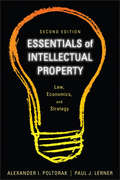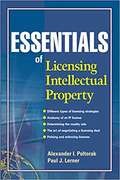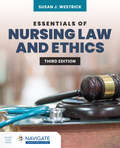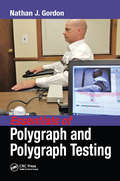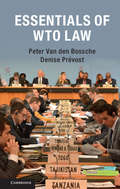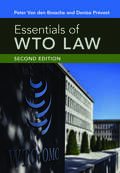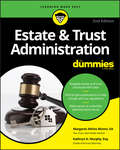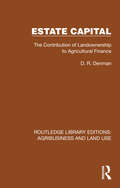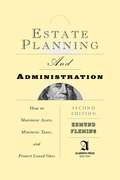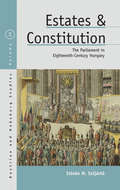- Table View
- List View
Essentials of Intellectual Property
by Alexander I. Poltorak Paul J. LernerThe definitive primer on intellectual property for business professionals, non-IP attorneys, entrepreneurs, and inventorsFull of valuable tips, techniques, illustrative real-world examples, exhibits, and best practices, the Second Edition of this handy and concise paperback will help you stay up to date on the newest thinking, strategies, developments, and case law in intellectual property.Presents fundamentals of patents, trademarks, copyrights, trade secrets and other less-know forms of IP, such as registered design and mask worksCovers important concepts such as IP strategy, protection, audits, valuation, management, and competitive intelligenceOffers an introduction to IP licensing and enforcementNow features discussion of critical precedent-setting recent IP cases and proposed patent reformProviding business professionals and IP owners with in-depth knowledge of this extremely important subject, this book helps those new to this field gain a better understanding and appreciation for the results of their creative abilities.
Essentials of Intellectual Property Rights: China’s Experience and Contribution (Masterpieces of Contemporary Jurisprudents in China)
by Handong WuWhile undertaking economic, social and judicial transformations unprecedented both in speed and scope, China is finding its ways to establish an IPRs’ regime with its own characteristics. Could China maintain its distinctive IPRs regime while honoring the international IPRs conventions? Have rights of IP holders been duly protected in China? How would China further enhance its IPRs legislation and enforcement in the near future? Handong Wu, China’s leading IPRs scholar, offers his insights from a nongovernmental perspective in hopes of providing readers, both general and academic, a vivid reflection of the IPRs system in China.
Essentials of Law and Ethics for Pharmacy Technicians (Pharmacy Education Series)
by Kenneth M. StrandbergAs the practice of modern medicine becomes more and more pharmacology dependent, the role of pharmacy technicians is becoming more complex. This is true in terms of the medications they are required to deliver, as well as the legal responsibilities and ethical considerations that come with administering those medicines. Essentials of Law and Ethics
Essentials of Licensing Intellectual Property
by Alexander I. Poltorak Paul J. LernerFull of valuable tips, techniques, illustrative real-world examples, exhibits, and best practices, this handy and concise paperback will help you stay up to date on the newest thinking, strategies, developments, and technologies in licensing intellectual property.
Essentials of Nursing Law and Ethics
by Susan J. WestrickEssentials of Nursing Law and Ethics continues its focus on the legal aspects of Nursing as it relates to patient safety and quality, environmental health and safety, error reduction and ethical boundaries of practice in an updated third edition. Written by a nurse attorney, this unique text presents complex topics to undergraduate nursing students in an understandable manner while providing accurate and well researched content relevant to nursing practice. The Third Edition was thoughtfully revised and updated to incorporate gender neutral, inclusive, patient-centered and person-first language throughout. Furthermore, it features new and updated case law examples and updated coverage of timely topics, including documentation, patient teaching, confidentiality, end of life issues, advance directives, refusing a patient assignment, sexual harassment in the workplace, use of social media by nurses, error reduction/disclosure, correctional nursing, age discrimination, the ADA, and more.
Essentials of Polygraph and Polygraph Testing
by Nathan J. GordonThroughout history, there has been an intrinsic need for humans to detect deception in other humans. Developed in 1923, the polygraph machine was a tool designed to do just this. To date, there have been many improvements made to the basic polygraph instrument. This book outlines the instrumentation as well as the latest in questioning techniques and methods available to the professional interviewer to determine truth from deception. The book covers psychology and physiology, a history of polygraph with the advances of leading figures, question formulation, data analysis, legal implications and legal cases, and the author’s developed technique Integrated Zone Comparison Technique (IZCT).
Essentials of Practical Real Estate Law (Sixth Edition)
by Daniel F. HinkelMaster the essentials of real estate law and develop a strong understanding of the role of the real estate paralegal with this concise, yet comprehensive text. Taking a case-based approach, ESSENTIALS OF PRACTICAL REAL ESTATE LAW, 6e details the transactional aspects of the law needed to assist attorneys with closing real estate purchases, sales, and mortgage loans secured by real estate. Case summaries throughout give you a chance to practice your analytical skills and see how concepts are applied in practice. In addition, each chapter includes practical assignments and a self-study examination, along with numerous forms and checklists, to ensure that you are well prepared to work as a professional in real estate. Offering up-to-date coverage of technology and the impact of the recent recession, this resource reflects the latest laws and regulations of the industry.
Essentials of Residential Property Management: Managing Single-Family Homes, Multi-Family Homes, and Community Associations (Springer Texts in Business and Economics)
by Daleik A. VaughnThis text provides students and instructors with an in-depth exploration into the management of single-family homes, manufactured home parks, and multi-family residences. It examines the essential principles and practices that underpin effective property management, providing a historical overview of the property management profession. The author also provides detailed discussions on the responsibilities of managing various types of residential properties, including themes such as development and implementation of maintenance plans, legal compliance, financial management, and risk migration. In addition, the book offers practical application, legal aspects of property management, and technological advances in the field, highlighting modern tools to streamline operations and enhance communications. Featuring learning objectives, key terms, review questions, and practical examples for effective teaching and learning, this text provides students with a thorough grounding in both the theoretical and practical aspects of residential property management, preparing them for real world-challenges.
Essentials of WTO Law
by Peter Denise Prévost Van Den Bossche Prévost DeniseAt a time when developments in WTO law have made this field increasingly complex, this concise and non-technical introduction provides a timely and carefully considered overview of the substantive rules and institutional arrangements of the WTO. A variety of text features enables a rich understanding of the law: illustrative examples clarify important issues of the law and demonstrate the law's practical application; boxed summaries of key rulings in WTO case law highlight the interpretation of the relevant provisions and lead readers to a deep understanding of the meaning and application of legal rules; and recommendations for further reading allow readers to engage with current debates. Online resources include links to useful sources of information for work and research within the field. Co-written by a leading authority in the field, this is essential reading for anyone who wants to get to grips with this fascinating yet challenging field of law.
Essentials of WTO Law
by Denise Prévost Peter Van den BosscheThe multilateral trading system and the WTO, its principal institution, are currently in crisis. Now more than ever, it is essential to provide a sound understanding of WTO rules and procedures, and their contribution to a secure and predictable framework for trading relations between nations. This book provides a timely and carefully considered overview of the substantive rules and institutional arrangements of the WTO, written in a concise and highly reader-friendly manner. It provides a clear and systematic discussion of key issues of WTO law, and incorporates important case law and current debates. It includes useful pedagogical features such as illustrative examples of the application of the legal framework to practical situations to facilitate understanding, as well as lists of further reading. Co-written by a leading authority in the field, it forms essential reading for anyone who wants to get to grips with this fascinating and challenging field of law.
Establishing Law and Order After Conflict
by Andrew Rathmell Seth G. Jones K. Jack Riley Jeremy M. WilsonIn a nation-building operation, outside states invest much of their resources in establishing and maintaining the host country's police, internal security forces, and justice system. This book examines post-Cold War reconstruction efforts, such as those in Iraq and Afghanistan, and assesses the success of U.S. and allied efforts in reconstructing internal security institutions.
Estate & Trust Administration For Dummies
by Margaret A. Munro Kathryn A. MurphyEstate and Trust Administration For Dummies, 2nd Edition (9781119543879) was previously published as Estate and Trust Administration For Dummies, 2nd Edition (9781118412251). While this version features a new Dummies cover and design, the content is the same as the prior release and should not be considered a new or updated product. Your plain-English guide to administering an estate and/or trust As more and more of the population reach senior ages—including baby boomers, many of whom do not have wills—an increasing number of people are being thrust into the role of executor, administrator, personal representative of an estate, or trustee of a trust after the death of a loved one. This updated edition of Estate & Trust Administration For Dummies guides you through the confusing process of administering an estate and/or trust. Settling an estate and administering a trust can be complicated, messy, and time-consuming for individuals named as executor or trustee, most of whom have no previous experience with such matters. Estate & Trust Administration For Dummies shows you how to make sound decisions for your unique circumstances. Guides you through the confusing process of administering an estate and/or trust Provides expert advice on unfamiliar estate and trust tax law Gives you a practical checklist to follow for all of your estate and trust administration questions and concerns Whether you're looking for guidance on how to navigate the probate process and estate taxes, settle debts and bequests, fund a trust, comply with tax regulations, or anything in between, this hands-on, friendly guide takes away the mystery and provides detailed answers to all of your estate and trust administration questions.
Estate Capital: The Contribution of Landownership to Agricultural Finance (Routledge Library Editions: Agribusiness and Land Use #5)
by D. R. DenmanOriginally published in 1957, this book introduces the term ‘estate capital’ to distinguish investment in land and buildings, in which agriculture rests, from investment in agricultural machinery and other forms of capital which are essentially agricultural. The book provides a general review of the formation of estate capital from estate income, the provision of estate capital from other sources the level of investment on agricultural estates. Concluding chapters describe the influence of estate character upon the formation, provision and investment level of estate capital. Estate duty levy on agricultural estates, tenants’ contributions to capital investment, and charity estates receive special attention.
Estate Planning (In Plain English)
by Amanda Bryan Leonard D. DuBoff"An invaluable tool to help you collect the information your attorney needs." —Michael Cragun, Utah State Tax Commissioner An Accessible Guide to Estate Planning With Estate Planning (in Plain English)®, readers will learn to comprehend the legal jargon and navigate the complex rules involved in preparing one’s estate. The authors provide clear information and cite actual cases to help readers approach the process with the confidence and knowledge they need to make the best decisions for their heirs. Chapters discuss important topics such as: Estate plans, wills, and a variety of trustsGuardians, powers of attorney, advance directives, and other essential documents. Life insurance Digital assets GiftsTax considerations Avoiding probate Identifying and caring for estate property Settling business assets Finding a lawyer An invaluable reference for those preparing their estates and for their families, Estate Planning (in Plain English)® will enable readers to take the necessary steps to preserve their legacies.
Estate Planning 101: From Avoiding Probate and Assessing Assets to Establishing Directives and Understanding Taxes, Your Essential Primer to Estate Planning (Adams 101)
by Vicki Cook Amy BlacklockDiscover the ins and outs of planning your own or your loved one&’s last wishes with this easy-to-understand guide to estate planning.No one likes to talk about death, but being prepared for any unexpected tragedy can help your loved ones navigate your loss more easily in the long run. From creating your advanced medical directives to designating your beneficiaries, estate planning can ensure that your wishes are carried out when you are no longer around. With Estate Planning 101, you can get your affairs in order before any unfortunate incident occurs. This easy-to-understand guide comes with detailed information on what needs to be done to protect your estate. With information on creating a living will, minimizing estate taxes, choosing an executor, and more, you will be prepared for the future, no matter what it brings. Estate Planning 101 offers you step-by-step instructions and checklists to keep you organized for whatever life throws your way.
Estate Planning Basics
by Denis CliffordThis book provides concise, straightforward, and easy-to-read information about the major components of estate planning – without going into endless detail about arcane options that apply only to the wealthy. Topics include: choosing beneficiaries estate planning by parents with minor children wills living trusts avoiding probate trusts for people in a second marriage, and planning for incapacity. Best-selling Nolo author Denis Clifford uses plain-English to make these estate planning issues easy to understand, and he lets you know which tasks you can handle yourself, and when you’ll need a lawyer’s help.
Estate Planning Basics
by Denis CliffordEstate planning, in plain English This book provides concise, straight forward, and easy to read information about the major components of estate planning – without going into endless detail about arcane options that apply only to the wealthy. Topics include: choosing beneficiaries estate planning by parents with minor children wills living trusts avoiding probate trusts for people in a second marriage, and planning for incapacity. Best-selling Nolo author Denis Clifford uses plain-English to make these estate planning issues easy to understand, and lets you know which tasks you can handle yourself, and when you’ll need a lawyer’s help.
Estate Planning Basics
by Denis CliffordThis book provides concise, straightforward, and easy to read information about the major components of estate planning – without going into endless detail about arcane options that apply only to the wealthy. Topics include: Wills. Why you need one, how to make one, and when having just a will is enough. Living Trusts. When they’re useful, how they work, and whether you need a lawyer to make one. Young Beneficiaries. How to protect gifts you leave to young people to young people, by naming a responsible adult to manage the property until they come of age. Avoiding Probate. What is probate, why you might want to avoid it, and how to do it. Planning for Incapacity. Why you should make powers of attorney and health care directives to plan for a time when you cannot make decisions about your finances or your medical care. Best-selling Nolo author Denis Clifford uses plain English to make these estate planning issues easy to understand, and he lets you know which tasks you can handle yourself and when you’ll need a lawyer’s help.
Estate Planning Basics
by Denis Clifford AttorneyEstate planning rules explained in one quick read! Estate Planning Basics provides concise, straightforward, and easy-to-read explanations of the major components of estate planning, so that you don't have to spend hours wading through endless options (most of which apply to the wealthy). Learn about: choosing beneficiaries estate planning by parents with minor children wills living trusts other probate-avoidance methods, including using a retirement plan like an IRA or 401(k) as an estate planning device estate taxes and tax-reduction methods trusts for people in second marriages, or for those leaving property to a disabled person planning for the handling of medical and financial decisions if one becomes incompetent Attorney Denis Clifford gives you the reliable, plain-English answers you need, whether you're doling out the family heirlooms or trying to steer clear of estate taxes. The 6th edition has been fully updated to reflect your state's latest estate planning laws and information.
Estate Planning Basics (4th edition)
by Denis CliffordFind out the fundamentals of estate planning, including wills, living trusts, estate taxes and more.
Estate Planning For Dummies
by Jordan S. Simon Joseph MashinskiGet your arms around wills, trusts, probate, inheritance taxes, and other important estate planning essentials Estate Planning For Dummies teaches you the ins and outs of estate planning. It’s all about drafting wills, dealing with probate, assigning powers of attorney, establishing living trusts, and beyond. Think you don’t have enough assets to merit estate planning? Think again. This everyone-friendly guide walks you through building a solid estate plan, whatever your current financial situation. In easy-to-understand language, you’ll learn the ins and outs of estate planning, including what happens to your stuff—cash, real estate, businesses, retirement funds, everything—when you pass away. This new edition is updated for the many recent changes in estate taxes and inheritance law. Make sure your assets get into the pockets of your heirs or wherever you want them to go, and learn how to accomplish it the For Dummies way. Understand state and federal estate and inheritance taxes Build an air-tight will and make sure your heirs get as much as they can Protect your estate’s privacy even after you’re gone Plan for the transition of a family business Prevent disagreements and uncertainty among your heirs Figure out how to pass on your digital assetsThis friendly guide is a must for people of any age in the process of drafting their wills and planning where their assets ultimately end up.
Estate Planning and Administration: How to Maximize Assets, Minimize Taxes, and Protect Loved Ones
by Edmund FlemingThe complexities of planning and administering an estate are clearly explained in this up-to-date and authoritative guide. This new edition covers the best techniques for transferring property through Irrevocable Life Insurance Trusts, gifting programs, paying grandchildren's medical and tuition expenses, and more. From wills, trusts, powers of attorney, and health care directives to probate and administering an estate, it's all here in easy-to-read, plain English. A five-step planning process details how to create and implement a sound estate plan.
Estate Planning for Blended Families
by Richard Barnes AttorneyIn almost half of all stepfamilies, each parent brings one or more children to a new marriage and while other books give general information about wills, trusts, and taxes, many of them may not apply to couples in second marriages. Estate Planning for Blended Families is the first book for parents in second marriages who want to provide both for their current spouse and their children from the current and prior marriages. Author Richard Barnes has years of experience guiding couples through the process of setting goals, discussing competing priorities, and choosing strategies and this book covers: Identifying goals and concerns Discussing matters with your spouse Planning for all children involved Estate and gift taxes in a second marriage Choosing executors and trustees Working with lawyers, financial planners and other experts And much more Estate Planning for Blended Families will also provide sample estate plans as well as the latest information regarding federal and state laws.
Estate and Trust Administration For Dummies
by Kathryn A. Murphy Margaret Atkins MunroYour plain-English guide to administering an estate and/or trustAs more and more of the population reach senior ages--including baby boomers, many of whom do not have wills--an increasing number of people are being thrust into the role of executor, administrator, personal representative of an estate, or trustee of a trust after the death of a loved one. This updated edition of Estate & Trust Administration For Dummiesguides you through the confusing process of administering an estate and/or trust. Settling an estate and administering a trust can be complicated, messy, and time-consuming for individuals named as executor or trustee, most of whom have no previous experience with such matters. Estate & Trust Administration For Dummies shows you how to make sound decisions for your unique circumstances. Guides you through the confusing process of administering an estate and/or trustProvides expert advice on unfamiliar estate and trust tax law Gives you a practical checklist to follow for all of your estate and trust administration questions and concernsWhether you're looking for guidance on how to navigate the probate process and estate taxes, settle debts and bequests, fund a trust, comply with tax regulations, or anything in between, this hands-on, friendly guide takes away the mystery and provides detailed answers to all of your estate and trust administration questions.
Estates and Constitution: The Parliament in Eighteenth-Century Hungary (Austrian and Habsburg Studies #30)
by István M. SzijártóAcross eighteenth-century Europe, political power resided overwhelmingly with absolute monarchs, with notable exceptions including the much-studied British Parliament as well as the frequently overlooked Hungarian Diet, which placed serious constraints on royal power and broadened opportunities for political participation. Estates and Constitution provides a rich account of Hungarian politics during this period, restoring the Diet to its rightful place as one of the era’s major innovations in government. István M. Szijártó traces the religious, economic, and partisan forces that shaped the Diet, putting its historical significance in international perspective.
